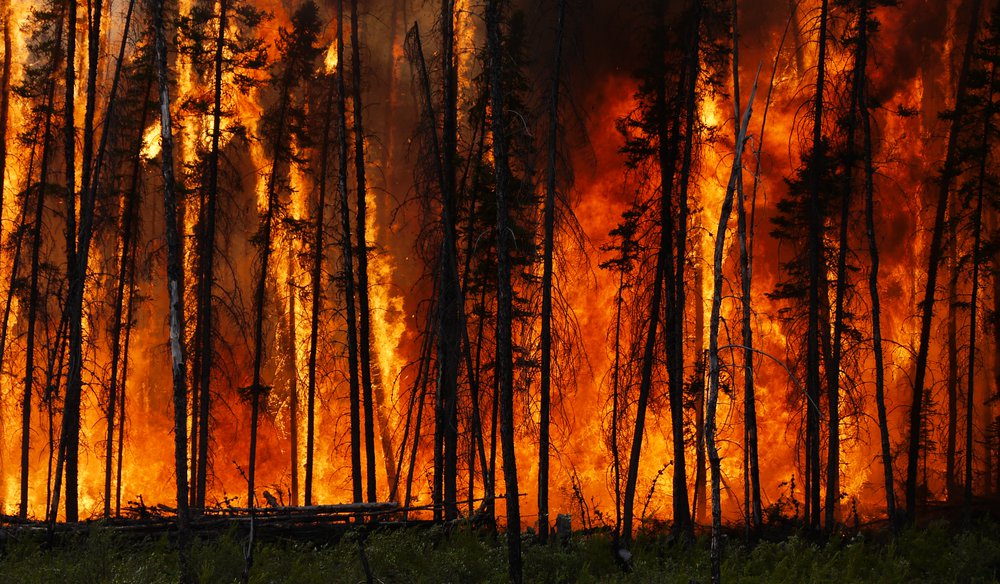News
Fighting fire with data: building a machine learning model to predict wildfire risk

Amii researchers have developed an AI model that can help predict wildfire risk and aid firefighting crews. (Photo: Stefan Doerr, used under Creative Commons licence)
This summer saw Canada's worst wildfire season in recorded history — more than 17 million hectares have burned as of September 22, according to Natural Resources Canada, more than double the previously held record. With so many fires out of control, it is vital for firefighters to allocate their resources as efficiently as possible.
A partnership between Amii and Canada Wildfire used machine learning to build a model to predict extreme fire risks, aiming to give firefighters time to focus resources on where they are most needed.
"This project focuses on predicting the fire weather index. That means, given the weather conditions, how likely is it that a wildfire will ignite and spread in a certain area?" says Jubair Sheikh, the Amii Machine Learning Scientist who led the project.
"If [firefighting crews] can more accurately predict the fire weather index, they can allocate their resources, or they can distribute the reserves more effectively."
"You won't find a transformer model like that in the literature. This is a novel model that we built just for this project."
Jubair Sheikh, Amii Machine Learning Scientist
A novel approach to fire prediction
Fire weather prediction isn't new, but Sheikh says the Amii team has taken a different approach. Traditionally, methods have employed a bounding box approach. This involves drawing out a particular area and analyzing weather data within that space to assess the chances that a wildfire might ignite nearby. However, Sheikh points out that this approach ignores what is happening outside the bounding box, which can make predictions less accurate.
Compared to traditional bounding box approaches where Convolutional Neural Networks are typically applied, the Amii team focused on determining the risk for specific locations by drawing on reanalysis weather data from other nearby places. To predict the fire weather index for a particular set of coordinates, data from that area was combined with data from the 25 nearest neighbouring regions. The data from nearby regions was weighted, based on how much impact they had on the target area. This allowed the predictions to take into account how conditions in a neighbouring area might affect the fire weather index of the target coordinates.
The Amii team used multiple types of data from these nearby points that could signal potential fire danger — surface temperature, precipitation, relative humidity, wind speed as well as geopotential heights and mean sea level pressure.
That data is then fed into a machine learning model developed by the team, trained on Canadian wildfire data from the past forty years. That, which Sheikh calls a "self-attention-based transformer-like model," can then predict what the fire weather index is for any given location.
"You won't find a transformer model like that in the literature. This is a novel model that we built just for this project," he says.
Combining time and space
Sheikh explains that the model they developed also has another advantage. The conventional bounding-box method of wildfire prediction can capture temporal and spatial interactions in the data; it might predict a high chance of a fire if the fire weather index has been high for the past few days (temporal) or is currently high in nearby locations (spatial).
The Amii model also does this, but it also considers temporal-spatial interactions: data that combines both the time and location aspects. This is very important, Sheikh says because weather is dynamic and can move over a region. For instance, if there is a storm in Calgary that is moving north, it is likely to affect Edmonton in the next few days.
"Think of it this way: there's a low chance your house will catch on fire most days. But, if a fire is currently raging at your neighbour's house, there is a higher likelihood that your own might also catch fire, right? So, in our models, we capture those kinds of interactions," he says.
The results have been promising. After six months of work, Sheikh says the model's predictions are encouraging. It allows them to make fire weather index forecasts for one to five days into the future. (The team initially also attempted a seven-day prediction but found that those were much less accurate.)
Sheikh explains that achieving an accurate five-day prediction was most important to the team. That kind of prediction could provide vital time for wildfire response teams to allocate and mobilize their firefighting resources. That would lead to increased safety and a better chance of limiting the damage done by wildfires.
While initial results have been promising, Sheikh is confident that the model can be even more accurate with additional work and training. He says the team also has other ideas to improve the model that they wish to explore.
Latest News Articles

Jul 24th 2024
News
Humans Make AI Better with Matt Taylor | Approximately Correct Podcast
How do we get the best results when AI and human beings work together? In this episode of Approximately Correct, we’re looking into Human-In-The-Loop AI with Amii Fellow and Canada CIFAR AI Chair Matt Taylor.

Jul 22nd 2024
News
Amii Monthly News - July 2024
Read our monthly update on Alberta’s growing machine intelligence ecosystem and exciting opportunities to get involved.

Jul 18th 2024
News
Empowering Founders: Amii’s Collaboration with Communitech Aims to Fuel AI Adoption
Amii announces work with Communitech, a Waterloo Region innovation hub, to empower startup founders with the AI tools and resources they need to integrate AI and build in-house capabilities successfully. The collaboration will leverage Amii’s leading AI expertise and resources and be centred around Amii’s Machine Learning Exploration (ML Exploration) program.
